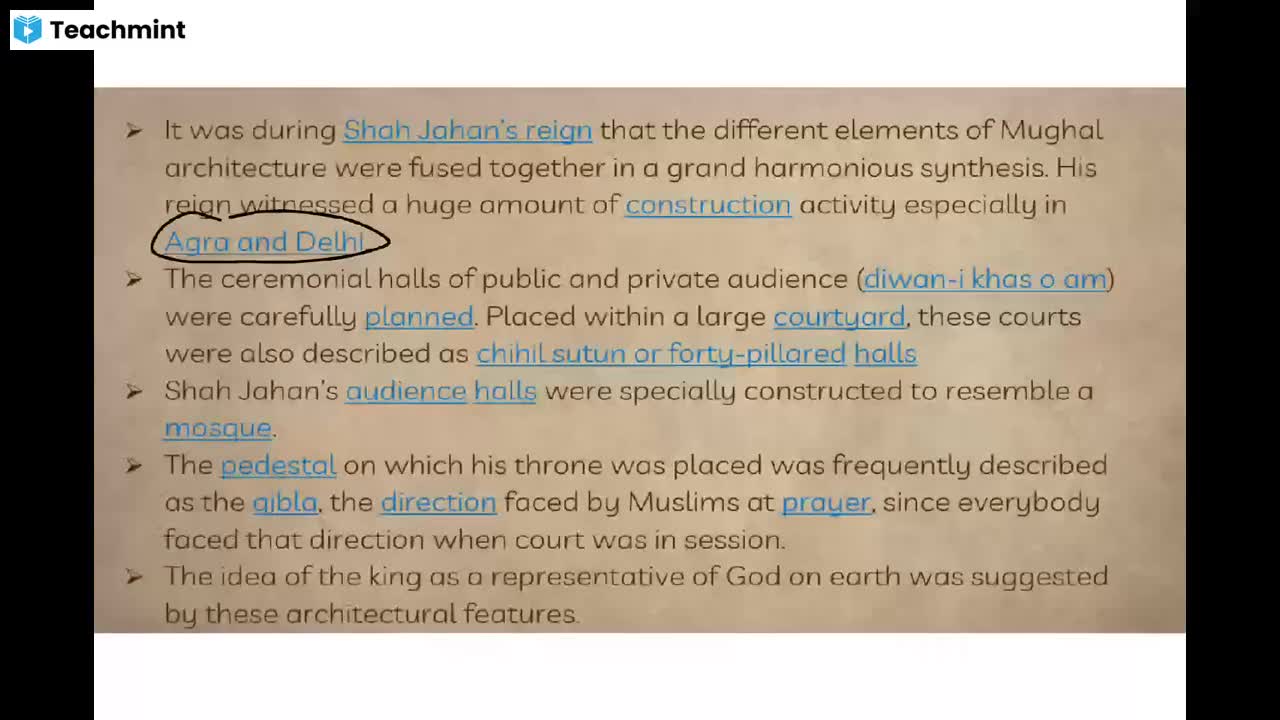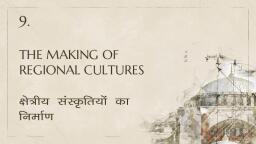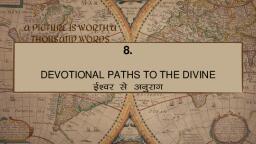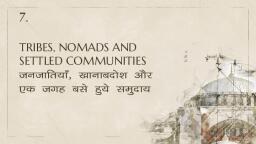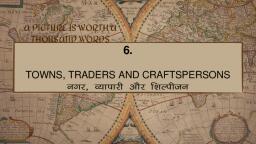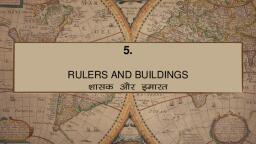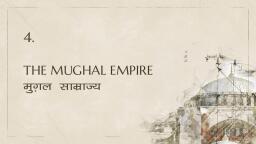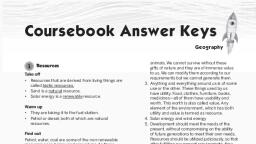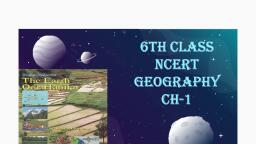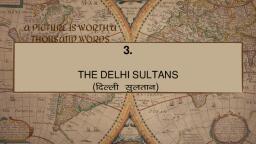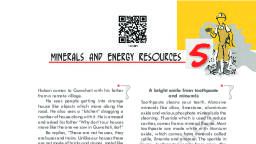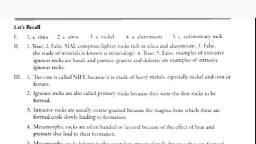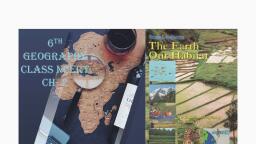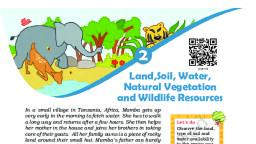Page 1 :
GEOGRAPHY, GRADE-7, , NCERT CH-1
Page 2 :
ENVIRONMENT (पर्या वरण), GEOGRAPHY, , ❖Introduction, ❖What is Environment?, ❖Components of Environment, ❖Natural Environment, ❖What is Eco-system?, ❖Human Environment
Page 3 :
❖ Have you ever come across a place near-by your, , surroundings which you have observed is continuously, changing over years?, ❖ What all is changing around you is created by humans or is, , it a natural phenomenon?, ❖ Let’s answer all these questions with reference to our, , INTRODUCTION, , chapter – Environment.
Page 4 :
WHAT IS ENVIRONMENT?, (पर्या वरण क्यय है ?), , ❖ The word Environment has been derived from French word “Environer/Environner” which means, , “neighbourhood.”, ❖ Environment is our basic life support system which provides the air we breathe, the water we drink,, , the food we eat and the land where we live., ❖ Environment is that place, people, things and nature that surrounds any living organism., ❖ It plays an important role in the existence of life on the planet earth and it is a combination of natural, , and human made phenomena.
Page 5 :
COMPONENTS OF ENVIRONMENT (पर्या वरण के भयग), The components of environment are basically divided into two categories:, ❖ Biotic environment – It refers to the world of living organism such as animals, birds, forests, insects,, , plants etc., ❖ Abiotic environment – It refers to the world of non-living elements created by the activities and, , interaction of human beings which include land, air, clouds, rivers, mountains, temperature etc.
Page 7 :
NATURAL, ENVIRONMENT, , Lithosphere (स्थलमंडल), ❖ It is the solid crust or the hard-top layer of the earth made up of, , Land, water, air, plants and, animals comprise the natural, environment., , rocks and minerals and covered by thin layer of soil., ❖ It is an irregular surface which has various landforms like, , mountains, plateaus, plains, valleys etc., ❖ Landforms are found over continents and also on the ocean floor., , Natural environment is, divided into various domains., They are:, , ❖ Lithosphere is the domain which provides us forests, grasslands, , for grazing, land for agriculture and human settlements., ❖ It is also a source of mineral wealth.
Page 8 :
NATURAL, ENVIRONMENT, , Hydrosphere (जल मंडल), ❖ The domain of water is known as hydrosphere., , ❖ It comprises various sources of water and water bodies like rivers,, , lakes, seas, oceans etc. which is essential for all living beings.
Page 9 :
NATURAL, ENVIRONMENT, , Atmosphere (वयर्ुमंडल), ❖ It is a thin layer that surrounds the earth., , Land, water, air, plants and, animals comprise the natural, environment., , ❖ It protects us from harmful rays and scorching heat of the sun., ❖ It consists of no. of gases, dust and water vapour., ❖ Any change in the atmosphere will lead to the change in weather, , and climatic conditions., Natural environment is, divided into various domains., They are:
Page 10 :
NATURAL, ENVIRONMENT, Land, water, air, plants and, animals comprise the natural, environment., , Natural environment is, divided into various domains., They are:, , Biosphere (जीवमंडल), ❖ Plants and animal kingdom together frame biosphere., ❖ It is a narrow zone of earth where land, water and air interact, , with each other to support all life forms.
Page 11 :
NATURAL ENVIRONMENT
Page 12 :
❖ It is a system formed by the interaction of all living, , WHAT IS, ECO-SYSTEM?, , (पयररस्थतिकी िंत्र), , organisms with each other. They interact physically and, chemically with the environment they live in and transfer, all their energy and material., ❖ All plants, animals and human beings depend on their, , immediate surroundings and they are often interdependent, on each other. This relationship between organism and, their surroundings form a part of ecosystem., ❖ Ecosystem could even consist of a large rain forest,, , grasslands, desert, mountains, lakes and a small pond.
Page 13 :
ECO-SYSTEM
Page 14 :
HUMAN ENVIRONMENT (मयनव पर्या वरण), , ❖ Human beings interact with each other and modify their surroundings according to their own needs like early, humans adapted themselves to their natural surroundings., ❖ The life of early human was life simple and their requirement was fulfilled by nature only., ❖ With time humans have learnt to grow crops, domesticate animals and change environment according t their, requirement., ❖ With the invention of wheel, surplus food was produced, barter system emerged (a system in which goods are, exchanged without the use of money) and humans came up with the idea of trade and commerce leading to, information and communication revolution.
Page 16 :
GEOGRAPHY, CLASS-7, , NCERT, , INSIDE OUR EARTH, , CHAPTER – 2
Page 17 :
INSIDE OUR EARTH, , Introduction, ❑ Interior of the Earth, ❑ Rocks and minerals, ❑ Types of Rocks, ❑ Rock Cycle, ❑
Page 18 :
INTRODUCTION, , • We, , all are living on this beautiful planet Earth, which is a, dynamic planet as it undergoes many changes inside and, outside., •We all have seen earth from outside, but have you ever, wondered what lies in the interior of the earth?, •What is the earth made up of?, •What all components it carries along with it?, •Let’s answer these question with reference to our chapter, – Inside our Earth
Page 19 :
INSIDE OUR EARTH (धरती के अंदर), , , , o, o, , o, , Our earth is just like an Onion made up of several, concentric (having common center) layers with one, inside another., It consists of 3 layers namely:, Uppermost layer also known as ‘Crust’, Middle layer also known as ‘Mantle’, Innermost layer known as ‘Core’
Page 20 :
Interior of, the Earth
Page 21 :
Uppermost layer or Crust (ऊपर की, परत), ✓ Crust, , is the uppermost layer over the Earth’s surface., ✓ It is the thinnest of all the layers., ✓ It is around 35 km on the continental masses and only 5, km on the ocean floors., ✓ The main mineral which is found on continental mass are, Silica and Aluminium (together they are known as sial)., ✓ The main mineral which is found on ocean floor of crust, is mainly Silica and Magnesium (together they are known as, sima).
Page 22 :
Middle layer or Mantle, Just beneath the crust is the mantle which, extends up to a depth of 2900 km below the, crust., According to the volume of the earth, 84% of, the earth consists of the mantle.,
Page 23 :
Innermost layer or Core, The innermost layer is the core with a radius of, about 3500 km., It is mainly made up of nickel and iron and, together they are called nife., Centre core has very high temperature and, pressure.,
Page 24 :
Rocks and Minerals (चट्टान ं और, खननज )ं, The earth crust is made up of various types of rocks., Any natural mass of mineral that makes up the earth, crust is termed as ‘Rock.’, Rocks can be categorized based on their color, size and, texture., There are 3 major types of rocks namely:, ✓ Igneous Rocks, ✓ Sedimentary Rocks, ✓ Metamorphic Rocks,
Page 25 :
Types of Rocks, Igneous Rocks (आतशी चट्टानें), , , TYPES OF ROCKS, , , , When molten magma cools, it becomes solid. Rocks thus, formed are called igneous rocks or primary rocks., There are two types of igneous rocks –Intrusive Igneous, Rocks and Extrusive Igneous Rocks.
Page 26 :
TYPES OF ROCKS, , ✓Extrusive Igneous Rocks:- The molten lava which is, coming out of the volcano from the interior to the, surface, it rapidly cools down and becomes solid. So,, the rocks formed in such a way on the crust are called, extrusive rocks., ✓Extrusive igneous rocks have a very fine-grained, structure, for e.g. Basalt., ✓Deccan plateau is made up of basalt rocks.
Page 27 :
TYPES OF ROCKS, , ✓Intrusive Igneous Rocks:- Sometimes the molten, magma from the volcano cools down inside the, earth’s surface only without coming out on the, surface. So, the rocks formed through this process, is known as intrusive igneous rocks., ✓They cool down slowly due to which they form, large grains., ✓Granite is an e.g. of such rocks.
Page 28 :
Sedimentary Rocks (अवसादी, चट्टानें), ❖ The, , TYPES OF ROCKS, , rocks roll down from a hill , they hit each other, and are broken down into smaller fragments. These, smaller particles are known as sediments., ❖ These sediments are transported by natural forces, like wind, water etc. and form a hard shape structure, of rocks called as sedimentary rocks., ❖ Common example of sedimentary rocks is, sandstone, which is made up of grains of sand.
Page 29 :
Metamorphic Rocks (रूपां तररत, चट्टानें), TYPES OF ROCKS, , ❑ Igneous and sedimentary rocks can be changed, into metamorphic rocks under great heat and, pressure., ❑ For example, clay changes into slate and, limestone changes into marble., ❑ These rocks later are used for construction, purposes for making roads, houses and buildings.
Page 30 :
Rock Cycle (शीला चक्र), ➢ One type of rock changes into another under certain, conditions in a cyclic manner. This process of, transformation of the rock from one another is known, as rock cycle., ➢ When the molten magma cools, it solidifies to become, igneous rocks and then igneous rocks are broken down, into smaller particles that are transported and deposited, to form sedimentary rocks., ➢ Then igneous and sedimentary rocks are subjected to, high heat and pressure to change them into, metamorphic rocks., ➢ Now the metamorphic rocks which are under heat, and pressure melt down to form molten magma . This, magma again cools down to form igneous rocks., ➢ This process continues to form a rock cycle.
Page 32 :
THANK YOU, Any doubts?
Page 33 :
GEOGRAPHY, CLASS 7, , NCERT, , OUR CHANGING EARTH, , CHAPTER – 3
Page 34 :
OUR CHANGING EARTH, ▪ Introduction, , ▪ Endogenic and Exogenic Forces, ▪ Volcano, ▪ Earthquake, ▪ Earthquake Preparedness, ▪ Major Landforms, ✓ Work of a river, ✓ Work of sea waves, ✓ Work of ice, ✓ Work of wind, ▪ Question bank
Page 35 :
INTRODUCTION, The lithosphere (as discussed in ch-1) is broken, into a number of plates known as the, Lithospheric plates. These plates move around, very slowly – just a few millimetres each year., This is because of the movement of the molten, magma inside the earth. The molten magma, inside the earth moves in a circular manner . The, movement of these plates causes changes on the, surface of the earth., Let’s learn more about these changing, movements in this chapter.,
Page 36 :
ENDOGENIC AND EXOGENIC FORCES, (विदे शी ताकते), (अंतर्ाा त बल), The movement of the earth is divided on the basis of forces, which cause them. These forces are :, , , , Endogenic Forces, , The forces which act, in the interior of, the earth are, called as, Endogenic forces, , , , Exogenic Forces, , The forces that work, on the surface of the, earth are called as, Exogenic forces
Page 38 :
VOLCANO (ज्वालामुखी), Endogenic forces sometimes produce sudden movements and at the, other times produce slow movements. Sudden movements like, earthquakes and volcanoes cause mass destruction over the surface, of the earth., A volcano is a vent (opening) in the earth’s crust through which, molten material erupts suddenly.,
Page 39 :
EARTHQUAKE (भूकंप), When the Lithospheric plates move, the surface of the earth, vibrates. The vibrations can travel all round the earth. These, vibrations are called earthquakes., The place in the crust where the movement starts is called the, focus. (the origin of the movement), The place on the surface above the focus is called the epicentre., Vibrations travel outwards from the epicentre as waves., Greatest damage is usually closest to the epicentre and the, strength of the earthquake decreases away from the centre.,
Page 40 :
Earthquakes cannot be predicted, but the impact can, certainly be minimized if we are prepared before-hand., o Some common earthquake prediction methods, adopted locally by people include studying animal, behavior for eg; fish in the ponds get agitated, snakes, come to the surface., o
Page 41 :
o Earthquake, , is measured with a machine called, , seismograph., o The magnitude of the earthquake is measured on, the Richter scale., o An earthquake of 2.0 or less can only be felt a, little., o An earthquake of 5.0 magnitude can cause, damage to infrastuctures., o An earthquake of 6.0 or 7.0 magnitude is, considered as very strong and known as major, earthquake.
Page 42 :
EARTHQUAKE PREPAREDNESS (भूकंप की त्यारी), Where to take shelter during an earthquake : Safe Spot – Under a kitchen counter, table or, desk, against an inside corner or wall., Stay Away from – Fireplaces, areas around, chimneys, windows that shatter including, mirrors and picture frames., Be Prepared – Spread awareness amongst your, friends and family members and face any, disaster confidently.
Page 43 :
MAJOR LANDFORMS (प्रमुख भूवम रूप )ं, The landscape is being continuously worn away by two processes –, weathering and erosion., Weathering is the breaking up of the rocks on the earth’s surface., Erosion is the wearing away of the landscape by different agents, like water, wind and ice., The eroded material is carried away or transported by water, wind,, etc. and eventually deposited somewhere. This process of erosion, and deposition create different landforms on the surface of the, earth., Let’s read about the major landforms.,
Page 44 :
WORK OF A RIVER (नदी का काम), , , The running water in the river erodes the landscape. When the, river tumbles at steep angle over very hard rocks or down a steep, valley side it forms a waterfall.
Page 45 :
o As, , the river enters the plain it twists and turns forming, large bends known as meanders., o Due to continuous erosion and deposition along the, sides of the meander, the ends of the meander loop come, closer and closer. In due course of time the meander loop, cuts off from the river and forms a cut-off lake, also, called an ox-bow lake., o At times the river overflows its banks. This leads to the, flooding of the neighboring areas. As it floods, it deposits, layers of fine soil and other material called sediments, along its banks. This leads to the formation of a flat, fertile floodplain., o The raised banks are called levees.
Page 46 :
o The, , river approaches the sea, the speed of the, flowing water decreases, and the river begins to, break up into several streams called, distributaries., o The river becomes so slow that it begins to, deposit its load. Each distributary forms its own, mouth., o The collection of sediments from all the mouths, forms a delta.
Page 47 :
WORK OF SEA WAVES (समुद्र की लहर ं का काम ), , , , , , , , , , , The erosion and deposition of the sea waves gives rise, to coastal landforms., Seawaves continuously strike at the rocks. And cracks, develop over time. They become larger and wider., Thus, hollow like caves are formed on the rocks. They, are called sea caves., As these cavities become bigger and bigger only the, roof of the caves remain, thus forming sea arches., Further, erosion breaks the roof and only walls are, left. These wall-like features are called stacks., The steep rocky coast rising almost vertically above, sea water is called sea cliff. The sea waves deposit, sediments along the shores forming beaches.
Page 48 :
Features made by sea waves
Page 49 :
WORK OF ICE (बर्ा का काम), Glaciers are “rivers of ice” which too erode the landscape by, bulldozing (destroying) soil and stones to expose the solid rock, below., Glaciers carve out deep hollows there. As the ice melts they get, filled up with water and become beautiful lakes in the mountains., The material carried by the glacier such as rocks big and small,, sand and silt gets deposited. These deposits form glacial moraines.,
Page 50 :
WORK OF WIND (हिा का काम), , , , , , , , , An active agent of erosion and deposition in the, deserts is wind., In deserts rocks in the shape of a mushroom are, common, known as mushroom rocks., Winds erode the lower section of the rock more than, the upper part. Therefore, such rocks have narrower, base and wider top., When the wind blows, it lifts and transports sand, from one place to another. When it stops blowing the, sand falls and gets deposited in low hill – like, structures. These are called sand dunes., When the grains of sand are very fine and light, the, wind can carry it over very long distances. When such, sand is deposited in large areas, it is called loess., Large deposits of loess is found in China.
Page 51 :
Sand Dunes
Page 52 :
QUESTION BANK, ❖ Tick the correct answer :-, , 1) Which is not an erosional feature of sea waves?, (a) Cliff (b) Beach (c) Sea cave, 2) The depositional feature of a glacier is:, (a) Flood plain (b) Beach (c) Moraine, 3) Which is caused by the sudden movements of the earth?, (a) Volcano (b) Folding (c) Flood plain, , 4) Mushroom rocks are found in:, (a) Deserts (b) River valleys (c) Glaciers, 5) Ox bow lakes are found in:, (a) Glaciers (b) River valleys (c) Deserts
Page 53 :
THANK YOU, Any Doubts?
Page 54 :
GEOGRAPHY, CLASS 7, , AIR, , NCERT, , CHAPTER – 4
Page 55 :
AIR, Introduction, , Composition of the Atmosphere, Structure of the Atmosphere, , Weather and Climate, Question Bank
Page 56 :
Introduction, Our earth is surrounded by a huge blanket of air called, , atmosphere. All living beings on this earth depend on the, atmosphere for their survival., It provides us the air we breathe and protects us from the, harmful effects of the sun’s rays. Without this blanket of, protection, we would be baked alive by the heat of the, sun during day and get frozen during night. So it is this, mass of air that has made the temperature on the earth, liveable.
Page 57 :
Composition of the Atmosphere, (वातावरण की रचना), , The air we breathe is actually a mixture of many gases., , Nitrogen and oxygen are two gases which make up the bulk, , of the atmosphere. Carbon dioxide, helium, ozone, argon and, hydrogen are found in lesser quantities., Apart from these gases, tiny dust particles are also present in, the air.
Page 58 :
Components of Atmosphere Nitrogen, Nitrogen is the most plentiful gas in the air. When we inhale, we take some, , amount of nitrogen into our lungs and exhale it., But plants need nitrogen for their survival. They can not take nitrogen directly, from the air., Bacteria, that live in the soil and roots of some plants, take nitrogen from the air, and change its form so that plants can use it.
Page 59 :
Components of Atmosphere Oxygen, Oxygen is the second most plentiful gas in the air., Humans and animals take oxygen from the air as they breathe., , Green plants produce oxygen during photosynthesis. In this way oxygen, , content in the air remains constant., If we cut trees then this balance gets disturbed.
Page 60 :
Components of Atmosphere – Carbon, Dioxide, Carbon dioxide is another important gas., , Green plants use carbon dioxide to make their food and release oxygen., , Humans or animals release carbon dioxide., The amount of carbon dioxide released by humans or animals seems to be equal, to the amount used by the plants which make a perfect balance., However, the balance is upset by burning of fuels, such as coal and oil. They add, billions of tons of carbon dioxide into the atmosphere each year., As a result, the increased volume of carbon dioxide is affecting the earth’s, weather and climate.
Page 61 :
Structure of the Atmosphere, Our atmosphere is divided into five layers starting from the earth’s, , surface., These are Troposphere, Stratosphere, Mesosphere, Thermosphere, and Exosphere.
Page 62 :
Troposphere (क्षोभ मंडल), This layer is the most important layer of the atmosphere. Its, , average height is 13 km. The air we breathe exists here., Almost all the weather phenomena like rainfall, fog and hailstorm, occur in this layer.
Page 63 :
Stratosphere (समताप मंडल), Above the troposphere lies the stratosphere., , It extends up to a height of 50 km., This layer is almost free from clouds and associated weather, , phenomenon, making conditions most ideal for flying airplanes., One important feature of stratosphere is that it contains a layer of, ozone gas and it protects us from the harmful effect of the sun, rays.
Page 64 :
Mesosphere (मीसोस्फीयर), This is the third layer of the atmosphere., It lies above the stratosphere., It extends up to the height of 80 km., Meteorites burn up in this layer, , on entering from the space.
Page 65 :
Thermosphere (बाह्य वायुमंडल), In thermosphere temperature rises very rapidly with increasing, , height., Ionosphere is a part of this layer. It extends between 80-400 km., This layer helps in radio transmission. In fact, radio waves, transmitted from the earth are reflected back to the earth by this, layer.
Page 66 :
Exosphere (बहिमंडल), The upper most layer of the atmosphere, , is known as exosphere., This layer has very thin air., Light gases like helium and hydrogen, float into the space from here.
Page 67 :
Weather and Climate (मौसम और, जलवायु), Weather is this hour-to-hour, day to day condition of the, , atmosphere., For Eg. A hot or humid weather may make one irritable. A, pleasant, breezy weather may make one cheerful and even plan for, an outing., Weather can change dramatically from day to day., However, the average weather condition of a place for a longer, period of time represents the climate of a place.
Page 68 :
Temperature (तापमान), The temperature you feel everyday is the temperature of the atmosphere., The degree of hotness and coldness of the air is known as temperature., , The temperature of the atmosphere changes not only between day and night but, , also from season to season. Summers are hotter than winters., An important factor that influences the distribution of temperature is Insolation, (आतपन), Insolation is the incoming solar energy intercepted by the earth., The amount of insolation decreases from the equator towards the poles., , Therefore, the temperature decreases in the same manner. Now do you, understand why poles are covered with snow?
Page 69 :
Temperature, If the earth’s temperature rises too high, it would become, , too warm for some crops to grow., Temperature in cities is much higher than that of villages., The concrete and metals in buildings and the asphalt, of roads get heated up during the day., This heat is released during the night., Also, the crowded high rise buildings of the cities, trap the warm air and thus raise the, temperature of the cities.
Page 70 :
Air Pressure (िवा का दबाव), Air pressure is defined as the pressure exerted by the weight of air on the, , , , , , , , , , earth’s surface., As we go up the layers of atmosphere, the pressure falls rapidly., The air pressure is highest at sea level and decreases with height. Horizontally, the distribution of air pressure is influenced by temperature of air at a given, place., In areas where temperature is high the air gets heated and rises. This creates a, low-pressure area. Low pressure is associated with cloudy skies and wet, weather., In areas having lower temperature, the air is cold. It is therefore heavy. Heavy, air sinks and creates a high pressure area., High pressure is associated with clear and sunny skies. The air always moves, from high pressure areas to low pressure areas.
Page 71 :
Air Pressure
Page 72 :
Wind (िवा), The movement of air from high pressure area to low pressure areas is called, , wind., Sometimes when the wind blows gently you can even see it blowing away, smoke or fine dust., At times wind can be so strong that it is difficult to walk against it.You must, have experienced it is not easy to hold an umbrella on a windy day.
Page 73 :
Wind, Winds can be broadly divided into three types., , 1. Permanent winds – The trade winds, westerlies and easterlies are, the permanent winds. These blow constantly throughout the year, in a particular direction., 2. Seasonal winds – These winds change their direction in different, seasons. For example monsoons in India., 3. Local winds – These blow only during a particular period of the, day or year in a small area. For example, land and sea breeze
Page 74 :
Major Pressure Belts and, Wind System
Page 75 :
Moisture (नमी), When water evaporates from land and different water bodies, it becomes water, , vapour. Moisture in the air at any time, is known as humidity., When the air is full of water vapour we call it a humid day. As the air gets, warmer, its capacity to hold the water vapour increases and so it becomes more, and more humid., On a humid day, clothes take longer to dry and sweat from our body does not, evaporate easily, making us feel very uncomfortable.
Page 76 :
➢ When the water vapour rises, it starts cooling. The water vapour condenses causing, , formation of droplets of water., ➢ Clouds are just masses of such water droplets. When these droplets of water become, too heavy to float in air, then they come down as precipitation., ➢ Precipitation that comes down to the earth in liquid form is called rain., ➢ Most of the ground water comes from rainwater. Plants help preserve water. When, trees on hill sides are cut, rainwater flows down the bare mountains and can cause, flooding of low lying areas., ➢ On the basis of mechanism, there are three types of rainfall: the convectional rainfall,, the orographic rainfall and the cyclonic rainfall.
Page 77 :
Rainfall is very important for the survival of plants and animals. It, brings fresh water to the earth’s surface. If rainfall is less – water, scarcity and drought occur. On the other hand if it is more, floods, take place.
Page 78 :
Question Bank, Tick the correct answer:-, , 1) Which of the following gases protects us from harmful sun ways, (a) Carbon dioxide (b) Nitrogen (c) Ozone, 2) The most important layer of the atmosphere is, (a) Troposphere (b) Thermosphere (c) Mesosphere, 3) Which of the following layers of the atmosphere is free from clouds?, (a) Troposphere (b) Stratosphere (c) Mesosphere, 4) As we go up the layers of the atmosphere, the pressure, (a) Increases (b) Decreases (c) Remains the same, 5) When precipitation comes down to the earth in the liquid form, it is called, (a) Cloud (b) Rain (c) Snow
Page 79 :
Thank You, Any Doubts?
Page 80 :
GEOGRAPHY, CLASS 7, , WATER, , NCERT, , CHAPTER – 5
Page 81 :
WATER, Introduction, ❑ Water Cycle, ❑ Distribution of water bodies, ❑ Ocean circulation, ❑ Ocean Currents, ❑ Question Bank, ❑
Page 82 :
Introduction, When you think of water, what images come to, your mind? You think of rivers, the waterfalls,, the pitter patter of raindrops, water in your, taps..., After rain, the water collects in a pit, but as the, sunrises it vanishes., Where does the water go?, Let’s read about water in this chapter.
Page 83 :
Water Cycle (जल चक्र), , , , , , , The sun’s heat causes evaporation of water into vapour., When the water vapour cools down, it condenses and, forms clouds. From there it may fall on the land or sea, in the form of rain, snow or sleet., The process by which water continually changes its, form and circulates between oceans, atmosphere and, land is known as the water cycle., Our earth is like a terrarium. The same water that, existed centuries ago still exists today.
Page 84 :
Water Cycle
Page 85 :
✓ The major sources of fresh water are the rivers,, ponds, springs and glaciers. The ocean bodies and the, seas contain salty water. The water of the oceans is salty, or saline as it contains large amount of dissolved salts., Most of the salt is sodium chloride or the common, table salt that you eat.
Page 86 :
Distribution of Water Bodies, , , •, , •, •, •, , Water is absolutely essential for survival. Water alone can quench, our thirst when we are thirsty., Three-fourth of the earth surface is covered by water. If there is, more water than land on this earth, why do so many countries face, water scarcity?, Is all the water on earth available to us?, Let’s see how much water is available for our use., The following table gives the distribution of water in percentage:
Page 87 :
Distribution of Water bodies, Oceans, , 97.3, , Saline Water, , Ice caps, , 02.0, , Ground Water, , 0.68, , Fresh Water lakes, , 0.009, , Fresh, , Inland seas and salt, lakes, , 0.009, , Water, , Atmosphere, , 0.0019, , Rivers, , 0.0001, , Total, , 100.0
Page 88 :
Ocean Circulation (समुद्र का, प्रचलन), There is something magical about walking bare feet on the, , , , , seashore. The wet sand on the beach, the cool breeze, the seabirds,, the smell of the salt in the air and music of the waves; everything is, so fascinating., Unlike the calm waters of ponds and lakes, ocean water keeps, moving continuously. It is never still. The movements that occur in, oceans can be broadly categorized as: waves, tides and currents.
Page 89 :
Waves (लहर), When the water on the surface of the ocean rises and, falls alternately, they are called waves., During a storm, the winds blowing at very high speed, form huge waves. These may cause tremendous, destruction., An earthquake, a volcanic eruption or underwater, landslides can shift large amounts of ocean water. As a, result a huge tidal wave called tsunami, that may be as, high as 15m., is formed., The largest tsunami ever measured was 150m. high. The, tsunami of 2004 caused wide spread damage in the, coastal areas of India. The Indira point in the Andaman, and Nicobar islands got submerged after the tsunami.,
Page 90 :
WAVES, , TSUNAMI
Page 91 :
Tides (ज्वार), , , , , , , The rhythmic rise and fall of ocean water twice in a day is called a, tide., It is high tide when water covers much of the shore by rising to its, highest level. It is low tide when water falls to its lowest level and, recedes from the shore., The strong gravitational pull exerted by the sun and the moon on, the earth’s surface causes the tides. The water of the earth closer, to the moon gets pulled under the influence of the moon’s, gravitational force and causes high tide.
Page 92 :
➢ During the full moon and new moon days, the sun, the moon and, , the earth are in the same line and the tides are highest. These tides, are called spring tides., ➢ But when the moon is in its first and last quarter, the ocean, waters get drawn in diagonally opposite directions by the, gravitational pull of sun and moon resulting in low tides. These tides, are called neap tides
Page 93 :
➢ High tides help in navigation.They raise the water level, , close to the shores. This helps the ships to arrive at the, harbour more easily., ➢ The high tides also help in fishing. Many more fish come, closer to the shore during the high tide. This enables, fishermen to get a plentiful catch., ➢ The rise and fall of water due to tides is being used to, generate electricity in some places.
Page 94 :
Ocean currents (महासागर धारा), , , , , , , Ocean currents are streams of water flowing constantly, on the ocean surface in definite directions., The ocean currents may be warm or cold., Generally, the warm ocean currents originate near the, equator and move towards the poles., The cold currents carry water from polar or higher, latitudes to tropical or lower latitudes., The Labrador Ocean current is cold current while the, Gulf Stream is a warm current.
Page 95 :
o The ocean current influence the temperature conditions of the, , area., o Warm currents bring about warm temperature over land surface., The areas where the warm and cold currents meet provide the, best fishing grounds of the world., o Seas around Japan and the eastern coast of North America are, such examples., oThe areas where a warm and cold current meet also experience, foggy weather making it difficult for navigation.
Page 97 :
Question Bank, Tick the correct answer., , 1) The process by which water continually changes its form and, circulates between oceans, atmosphere and land, (a) Water cycle (b) Tides (c) Ocean currents, 2) Generally the warm ocean currents originate near, (a) Poles (b) Equator (c) None of these, 3) The rhythmic rise and fall of ocean water twice in a day is called, (a) Tide (b) Ocean current (c) Wave
Page 99 :
NCERT, , CLASS - 7, , CHAPTER – 6, , Natural Vegetation and, Wildlife
Page 100 :
Natural Vegetation and Wildlife, (प्राकृतिक वनस्पति और वन्य जीवन), , , , , , , , , , Introduction, Tropical Evergreen Forests, Tropical Deciduous Forests, Temperate Evergreen Forests, Temperate Deciduous Forests, Mediterranean Vegetation, Coniferous Forests, Grasslands, , FORESTS
Page 101 :
INTRODUCTION, There is a close relationship between height of land and, , the character of vegetations. With the change in height, the, climate changes and that changes natural vegetation., The growth of vegetation depends on temperature and, moisture. It also depends on factors like slope and, thickness of soil., The type and thickness of natural vegetation varies from, place to place because of the variation in factors., Natural vegetation is generally classified in to three broad, categories as follows:
Page 102 :
(a) Forests: Which grow where temperature and rainfall are, plentiful to support a tree cover. Depending upon these factors,, dense and open forests are grown., (b) Grasslands: Which grow in the region of moderate rain., (c) Shrubs: Thorny shrubs and scrubs grow in the dry region
Page 103 :
FORESTS (जंगल), The changes in the type of natural, , vegetation occur mainly because of the, changes of climatic condition., Let us get to know the different types, of natural vegetation of the world with, their characteristic features and wildlife inhabiting, there.
Page 104 :
Tropical Evergreen Forests, (उष्णकतिबंधीय सदाबहार जंगल), These forests are also called tropical rainforests., , These thick forests occur in the regions near, , the equator and close to the tropics. These regions are, hot and receive heavy rainfall throughout the year., As there is no particular dry season, the trees do not, shed their leaves altogether. This is the reason they are called, evergreen., The thick canopies of the closely spaced trees do not allow the sunlight, to penetrate inside the forest even in the day time., Hardwood trees like rosewood, ebony, mahogany are common here.
Page 105 :
Tropical Deciduous Forests, (उष्णकतिबंधीय पर्णपािी वन), Tropical deciduous are the monsoon forests found in the large, , , , , , part of India, northern Australia and in central America., These regions experience seasonal changes. Trees shed their, leaves in the dry season to conserve water., The hardwood trees found in these forests are sal, teak, neem, and shisham., Hardwood trees are extremely useful for making furniture,, transport and constructional materials., Tigers, lions, elephants, langoors and monkeys are the common, animals of these regions.
Page 106 :
Tropical Deciduous Forests
Page 107 :
Temperate Evergreen Forest, (समशीिोष्ण सदाबहार वन), The temperate evergreen forests are, , located in the mid- latitudinal coastal, region., They are commonly found along the, eastern margin of the continents,, e.g., In south east USA, South China and, in South East Brazil., They comprise both hard and, soft wood trees like oak, pine, eucalyptus, etc.
Page 108 :
Temperate Deciduous Forests (शां ि, पर्णपािी जंगल), As we go towards higher latitudes, there are more temperate deciduous, , forests., These are found in the north eastern part of USA, China, New Zealand,, Chile and also found in the coastal regions of Western Europe., They shed their leaves in the dry season. The common trees are oak,, ash, beech, etc., Deer, foxes, wolves are the animals commonly found. Birds like, pheasants, monals are also found here .
Page 109 :
Mediterranean Forests (मध्ययुगीन, वनस्पति), The west and south west margins of the continents are different., They have Mediterranean vegetation . It is mostly found, in the areas around the Mediterranean sea in Europe,, Africa and Asia, hence the name., This kind of vegetation is also found outside the, actual Mediterranean region in California in the USA,, south west Africa, south western South America and South west Australia., These regions are marked for hot dry summers and mild rainy winters. Citrus, , fruits such as oranges, figs, olives and grapes are commonly cultivated here, because people have removed the natural vegetation in order to cultivate what, they want to., There isn’t much wildlife here.
Page 110 :
Coniferous Forests (शंकुधारी वन), In the higher latitudes (50° – 70°) of Northern hemisphere the, , , , , , , , , spectacular Coniferous forests are found. These are also called as Taiga., These forests are also seen in the higher altitudes. These are the trees, which Salima found in the Himalayas in abundance., They are tall, softwood evergreen trees. The woods of these trees are, very useful for making pulp, which is used for manufacturing paper, and newsprint., Match boxes and packing boxes are also made from softwood., Chir, pine, cedar are the important variety of trees in these forests., Silver fox, mink, polar bear are the common animals found here.
Page 111 :
Coniferous forest, , Snow covered Coniferous, forest
Page 112 :
Grasslands (घास स्थल), Tropical grasslands: These occur on either side of, , , , , , the equator and extend till the tropics ., This vegetation grows in the areas of moderate, to low amount of rainfall., The grass can grow very tall, about 3 to 4 metres, in height., Savannah grasslands of Africa are of this type., Elephants, zebras, giraffes, deer, leopards are common in tropical, grasslands.
Page 113 :
• Temperate grasslands: These are found in the mid- latitudinal zones and in the, , interior part of the continents. Usually, grass here is short and nutritious.Wild, buffaloes, bisons, antilopes are common in the temperate region., • Thorny bushes: These are found in the dry desert like regions. Tropical deserts, are located on the western margins of the continents. The vegetation cover is, scarce here because of scanty rain and scorching heat., ✓ The growth of natural vegetation is very limited here. Only mosses, lichens, and very small shrubs are found here., ✓ It grows during the very short summer. This is called Tundra type of, vegetation. This vegetation is found in the polar areas of Europe, Asia and North, America., ✓ The animals have thick fur and thick skin to protect themselves from the cold, climatic conditions. Seal, walruses, musk-oxen, Arctic owl, Polar bear and snow, foxes are some of the animals found here .
Page 114 :
Temperate grasslands, , Thorny bushes
Page 115 :
Question Bank, , , Tick the correct answer., 1) Mosses and Lichens are found in:, (a) Desertic Vegetation, (b) Tropical evergreen forest, 2) Thorny bushes are found in:, (a) Hot and humid tropical climate, , (c) Tundra vegetation, , (b) Hot and dry desertic climate (c) Cold polar climate, , 3) In tropical evergreen forest, one of the common animals is:, (a) Monkey, (b) Girraffe, (c) Camel, 4) One important variety of coniferous forest is:, (a) Rosewood, (b) Pine, 5) Steppe grassland is found in, (a) S. Africa, (b) Australia, , (c) Teak, , (c) Central Asia
Page 116 :
Any doubts?
Page 117 :
GEOGRAPHY, , NCERT, CLASS 7, CHAPTER – 7, , Human Environment –, Settlement, Transport and, Communication
Page 118 :
Human Environment – Settlement, Transport, and Communication, • Introduction, • Settlements, • Transport, • Roadways, • Railways, • Waterways, • Airways, • Communication, • Question Bank
Page 119 :
Introduction, • Early human beings depended entirely on nature for food, clothing and shelter; but, with time they learnt new skills to grow food, build homes and develop better, means of transport and communication. In this way they modified the environment, where they lived.
Page 120 :
Settlement (समझौता), • Settlements are places where people build their homes., • Early human beings lived on trees and in caves. When they started to grow crops it, became necessary to have a permanent home., • The settlements grew near the river valleys as water was available and land was, fertile., • With the development of trade, commerce and manufacturing, human settlements, became larger. Settlement flourished and civilizations developed near river valleys., , • Few names of civilization that grew along the banks of rivers are Indus, Tigris, Nile, and Hwang-He.
Page 121 :
✓ Settlements can be, , permanent or temporary., ✓ Settlements which are occupied for a short time are called temporary settlements., ✓ The people living in deep forests, hot and cold deserts and mountains often dwell in, such temporary settlements., ✓ They practice hunting, gathering, shifting cultivation and transhumance., ✓ However more and more settlements today are permanent settlements., ✓ In permanent settlements, people build homes to live in.
Page 122 :
Types of Settlements:▪ Rural Settlement (ग्रामीण बस्ती): The villages are rural settlement where, people are engaged in activities like agriculture, fishing,, forestry, crafts work and trading etc. Rural settlements, can be compact or scattered., , ▪ Compact Settlement (कॉम्पैक्ट बस्ती): A compact settlement is a closely, built area of dwellings, wherever flat land is available.
Page 123 :
▪ Scattered Settlement (बबखरी हुई बस्ती): In a scattered settlement dwellings are spaced, over an extensive area. This type of settlement is mostly found in hilly tracts, thick forests,, and regions of extreme climate., ▪ In rural areas, people build houses to suit their environment. In regions of heavy rainfall,, they have slanting roofs. Places where water accumulates in the rainy season the houses, are constructed on a raised platform or stilts., ▪ Thick mud walled houses with thatched roofs are very common in areas of hot climate., Local materials like stones, mud, clay, straw etc are used to construct houses.
Page 124 :
Settlement (शहरी बस्ती): The towns are small and the cities are larger, urban settlements. In urban areas the people are engaged in manufacturing,, trading, and services., ▪ Urban
Page 125 :
Transport (ट् ाांसपोटट ), • Transport is the means by which people and goods move., • In the early days it took a great deal of time, to travel long distances. People had to, walk and used animals to carry their goods., • Invention of the wheel made transport easier. With the passage of time different, means of transport developed but even today people use animals for transport. In, our country donkeys, mules, bullocks and camels are common., • In the Andes Mountains of South America, llamas are used, as are yaks in Tibet. The, early traders from other countries used to take several months to reach India. They, took either the sea route or the land route., • Airplanes have made travel faster. Now it takes only 6-8 hours to travel from India, to Europe. Modern means of transport thus saves time and energy., • The four major means of transport are roadways, railways, waterways and airways.
Page 126 :
TRANSPORT
Page 127 :
Roadways, • The most commonly used means of transport especially, for short distances are roads., • They can be metalled (pucca) and unmetalled (kutcha)., • The plains have a dense network of roads., , • Roads have also been build in terrains like deserts, forests and even high mountains., • Manali-Leh highway in the Himlayan Mountains is one of the, highest roadways in the world. Roads built underground are, called subways/under paths. Flyovers are built over raised structures.
Page 128 :
Railways (रे लवे), • The railways carry heavy goods and people over long distances quickly and cheaply., • The invention of the steam engine and the Industrial Revolution helped in speedy, development of rail transport., • Diesel and electric engines have largely replaced the steam engines. In places super, fast trains have been introduced to make the journey faster., • The railway network is well developed over the plain areas. Advanced technological, skills have enabled laying of railway lines in difficult mountain terrains also. But, these are much fewer in number., , • Indian railway network is well developed. It is the largest in Asia.
Page 129 :
INDIAN RAILWAYS
Page 130 :
Waterways (जलमार्ट), • Waterways are the cheapest for carrying heavy and bulky goods over long, distances., • They are mainly of two types – inland waterways and sea routes., • Navigable rivers and lakes are used as inland waterways., • Some of the important inland waterways are the Ganga-Brahmaputra river system,, the Great Lakes in North America and the river Nile in Africa., • Sea routes and oceanic routes are mostly used for transporting merchandise and, goods from one country to another., • These routes are connected with the ports.
Page 131 :
• Some of, , the important ports of the world are Singapore and Mumbai in Asia, New York, Los, Angeles in North America, Rio de Janerio in South America, Durban and Cape Town in Africa,, Sydney in Australia, London and Rotterdam in Europe.
Page 132 :
Airways (वायुमार्ट ), • This is the fastest way of transport developed in, the early twentieth century., • It is also the most expensive due to high cost of fuels., , • Air traffic is adversely affected by bad weather like fog and storms., • It is the only mode of transport to reach the most remote and distant areas, especially where there are no roads and railways., • Helicopters are extremely useful in most inaccessible areas and in time of, calamities for rescuing people and distributing food, water, clothes and medicines.
Page 133 :
Communication (सांचार), • Communication is the process of conveying messages to others. With the, development of technology humans have devised new and fast modes of, communication.
Page 134 :
o The, , advancement in the field of communication has brought about an information, revolution in the world., o Different modes of communication are used to provide information, to educate as well, as to entertain., o Through newspapers, radio and television we can communicate with a large number of, people. They are therefore called mass media.
Page 135 :
• The satellites have made communication even faster., , • Satellites have helped in oil exploration, survey of forest, underground water, mineral wealth, weather, forecast and disaster warning., • Now we can send electronic mails or e-mails through Internet., • Wireless telephonic communications through cellular phones have become very popular today., • Internet not only provides us with worldwide information and interaction but has also made our lives more, comfortable., • Now we can reserve tickets for railways, airways and even cinemas and hotels sitting at home., • With this kind of inter connectivity of people, services and institutions – across the world, we are a large, global society.
Page 136 :
Question Bank, • Tick the correct answer., , 1. Which is NOT a means of communication?, (a) telephone, , (b) books, , (c) table, , 2. Which type of road is constructed under the ground?, (a) fly over, , (b) expressways, , (c) subways, , 3. Which mode of transport is most suitable to reach an island?, (a) ship, , (b) train, , (c) car, , 4. Which vehicle does not pollute the environment, (a) cycle, , (b) bus, , (c) aeroplane
Page 137 :
THANK YOU, Any doubts?
Page 138 :
Human Environment, Interactions – The tropical, and subtropical region, , GEOGRAPHY, NCERT, CLASS 7, , CHAPTER – 8
Page 139 :
Human Environment Interactions – The, Tropical and Subtropical Region, • Introduction, • Life in the Amazon basin, • Climate, • Rainforests, • People of the rainforests, • Life in the Ganga - Brahmaputra, Basin, • Question Bank
Page 140 :
Introduction, • In this world, not all human beings belong to same part. Some are, from dry desert, some from frozen lands and some from wet, rainforests., , • They may look different, but they share the same basic needs of life, like food, clothing and shelter., • Human-environment interaction explains how man affects the, environment and gets affected by it., , • In this chapter we will learn about life of people in the different, regions of the world.
Page 141 :
Life in the Amazon Basin, •, , Look at the map and observe that tropical region, lies very close to the equator; between 10°N and 10°S., , So, it is referred to as the equatorial region., • The river Amazon flows through this region., • It flows from the mountains to the west and reaches, the Atlantic Ocean to the east., • The place where a river flows into another, body of water is called the river’s mouth., • Numerous tributaries join the Amazon River to form the Amazon basin. The river, basin drains portions of Brazil, parts of Peru, Bolivia, Ecuador, Columbia and a, small part of Venezuela.
Page 142 :
Climate (जलवायु), , • Amazon Basin stretches directly on the equator and is characterized, by hot and wet climate throughout the year., • Both day and nights are almost equally hot and humid. The skin feels, sticky., • It rains almost everyday, that too without much warning., • The day temperatures are high with very high humidity., , • At night the temperature goes down but the humidity remains high.
Page 143 :
Rainforests (वर्ाा वन), •, , It rains heavily in this region, so thick forests grow., , • The forests are in fact so thick that the dense “roof” created by leaves and, branches does not allow the sunlight to reach the ground. The ground remains, dark and damp. Only shade tolerant vegetation may grow here., • Orchids, bromeliads grow as plant parasites., • The rainforest is rich in fauna. Birds such as toucans, humming birds, bird of, paradise with their brilliantly colored plumage, oversized bills for eating make, them different from birds we commonly see in India. These birds also make loud, sounds in the forests., • Animals like monkeys, sloth and ant-eating, tapirs are found here.
Page 144 :
▪ Various, , species of reptiles and snakes also thrive in these jungles., ▪ Crocodiles, snakes, pythons abound. Anaconda and boa constrictor are, some of the species., ▪ Besides, the basin is home to thousands of species of insects., ▪ Several species of fishes including the flesh- eating Piranha fish is also found, in the river., ▪ This basin is thus extraordinarily rich in the variety of life found there.
Page 145 :
People of the Rainforests, • People grow most of their food in small areas after clearing some trees in, the forest., • While men hunt and fish along the rivers, women take care of the crops., • They mainly grow tapioca, pineapple and sweet potato., • As hunting and fishing are uncertain it is the women who keep their, families alive by feeding them the vegetables they grow., • They practice “slash and burn agriculture”. The staple food is manioc, also, known as cassava that grows under the ground like the potato., • They also eat queen ants and egg sacs., • Cash crops like coffee, maize and cocoa are also grown.
Page 146 :
• The, , rainforests provide a lot of wood for the houses., • Some families live in thatched houses shaped like beehives., • There are other large apartment-like houses called “Maloca” with a, steeply slanting roof., • Life of the people of the Amazon basin is slowly changing., • In the older days the heart of the forest, could be reached only by, navigating the river., • In 1970 the Trans Amazon highway made all parts of the rainforest, accessible., • Aircrafts and helicopters are also used for reaching various places.
Page 147 :
The indigenous population was pushed out from the area and forced, to settle in new areas where they continued to practice their distinctive, way of farming., • The developmental activities are leading to the gradual destruction of, the biologically diverse rainforests., • It is estimated that a large area of the rainforest has been disappearing, annually in the Amazon basin., • The topsoil is washed away as the rains fall and the lush forest turns into, a barren landscape., •
Page 148 :
Gradual destruction of Amazon Forest
Page 149 :
Life in the Ganga-Brahmaputra Basin, • The tributaries of rivers Ganga and Brahmaputra together form the, Ganga-Brahmaputra basin in the Indian subcontinent., • The basin lies in the sub-tropical region that is situated between, 10°N to 30°N latitudes., • The tributaries of the River Ganga like, the Ghaghra, the Son, the Chambal,, the Gandak, the Kosi and the tributaries, of Brahmaputra drain it.
Page 150 :
✓ The plains of the Ganga and the Brahmaputra, the mountains and the foothills of the, Himalayas and the Sundarbans delta are the main features of this basin., ✓ Ox-bow lakes dot the plain area., ✓ The area is dominated by monsoon climate. The monsoon brings rains from mid-June to, mid-September., ✓ The summers are hot and the winters cool., ✓ The basin area has varied topography. The environment plays a dominant role in the, distribution of the population., ✓ The mountain areas with steep slopes have inhospitable terrain. Therefore less number of, people live in the mountain area of the Ganga- Brahmaputra basin.
Page 151 :
• The plain area provides the most suitable land for human habitation., • The soil is fertile. Agriculture is the main occupation of the people where flat land is available, to grow crops., • The density of population of the plains is very high., •The main crop is paddy . Since cultivation of paddy requires sufficient water, it is grown in the, areas where the amount of rainfall is high., • Wheat, maize, sorghum, gram and millets are the other crops that are grown., • Cash crops like sugarcane and jute are also grown., • Banana plantations are seen in some areas of the plain., • In West Bengal and Assam tea is grown in plantations ., • Silk is produced through the cultivation of silk worms in parts of Bihar and Assam., • In the mountains and hills, where the slopes are gentle, crops are grown on terraces.
Page 152 :
❖ The vegetation cover of the area varies according to the type of landforms., ❖ In the Ganga and Brahmaputra plain tropical deciduous trees grow, along with teak, sal, and peepal., ❖ Thick bamboo groves are common in the Brahmaputra plain., ❖ The delta area is covered with the mangrove forests., ❖ In parts of Uttarakhand, Sikkim and Arunachal Pradesh, coniferous trees like pine, deodar, and fir can be seen because the climate is cool and the slopes are steep., ❖ There is a variety of wildlife in the basin. Elephants, tigers, deer and monkeys are common., ❖ The one-horned rhinoceros is found in the Brahmaputra plain., ❖ In the delta area, Bengal tiger, crocodiles and alligator are found., ❖ Aquatic life abounds in the fresh river waters, the lakes and the Bay of Bengal Sea., ❖ The most popular varieties of the fish are the rohu, catla and hilsa. Fish and rice is the staple, diet of the people living in the area.
Page 153 :
➢ The Ganga-Brahmaputra plain has several big towns and cities. The cities of Allahabad,, , Kanpur, Varanasi, Lucknow, Patna and Kolkata all with the population of more than ten lakhs, are located along the River Ganga ., ➢ The wastewater from these towns and industries is discharged into the rivers. This leads to, the pollution of the rivers. All the four ways of transport are well developed in the GangaBrahmaputra basin. In the plain areas the roadways and railways transport the people from, one place to another., ➢ The waterways, is an effective means of transport particularly along the rivers. Kolkata is an, important port on the River Hooghly., ➢ The plain area also has a large number of airports., ➢ Tourism is another important activity of the basin., ➢ Taj Mahal on the banks of River Yamuna in Agra, Allahabad on the confluence of the, Rivers Ganga and Yamuna, Buddhists stupas in Uttar Pradesh and Bihar, Lucknow with its, Imambara, Assam with Kaziranga and Manas with wild life sanctuaries and Arunachal, Pradesh with a distinct tribal culture are places worth visiting.
Page 154 :
Question Bank, • Tick the correct answer., 1) Toucans are a type of, (a) birds, (b) animals, 2) Manioc is the staple food of, (a) Ganga Basin, (b) Africa, 3) Kolkata is located on the river, (a) Orange, (b) Hooghly, 4) Deodars and firs are a type of, (a) Coniferous trees, (b) Deciduous trees, 5) Bengal tiger is found in, (a) Mountains, (b) delta area, , (c) crops, , (c) Amazon, (c) Bhagirathi, , (c) shrubs, (c) Amazon
Page 155 :
THANK, YOU
Page 156 :
GEOGRAPHY, NCERT, CLASS 7, CHAPTER – 9 (LIFE IN THE TEMPERATE, GRASSLANDS)
Page 157 :
LIFE IN THE TEMPERATE GRASSLANDS, Introduction, , ▪, ▪, ▪, , , ▪, ▪, ▪, , , The Prairies, Climate, Flora and Fauna, People, The Velds, Climate, Flora and fauna, People, Question Bank
Page 158 :
INTRODUCTION, , , , , , , , , Just as a forest can be defined as the place where trees are, the main type of vegetation, grassland can be defined as a, region where grasses form the dominant type of plant life., Grasslands make up almost a quarter of the total land, surface., The types of plants that grow here greatly depend on what, the climate and soil are like., As climate plays an important role in the formation of, grasslands, it is generally used as a basis to divide the, world’s grasslands into two broad categories: those that, occur in the temperate region and those that occur in the, tropical regions.
Page 159 :
THE PRAIRIES (घास के मैदान )ों, , , , , , , The temperate grasslands of North, America are known as the Prairies., It is a region of flat, gently sloping or hilly, land., For the most part, prairies are treeless, but, near the low lying plains, flanking, river valleys, woodlands can be found., Tall grass, up to two metres high,, dominates, the landscape., It is actually a “sea of grass.”
Page 160 :
• The prairies are bound by the Rocky, Mountains in the West and the Great Lakes, in the East., • The prairies cover parts of United States, of America and parts of Canada., • In the USA, the area is drained by the, tributaries of Mississippi and the, Canadian prairies are drained by the, tributaries of Saskatchewan Rivers.
Page 161 :
CLIMATE OF THE PRAIRIES, , , , , , , , , , Being located in the heart of a continent, the climate, is of continental type with extreme temperatures., The summers are warm with temperatures of around, 20°C, while in winter -20°C has been recorded in, Winnipeg, Canada., In winters a thick blanket of snow covers this region., The annual rainfall is moderate and is ideal for the, growth of grass., Due to the absence of the north-south barrier, a local, wind “Chinook” blows here.
Page 162 :
FLORA AND FAUNA OF THE PRAIRIES, , , , , , , Prairies are practically tree-less. Where water is available,, trees such as willows, alders and poplars grow., Places that receive rainfall of over 50 cm, are suitable for, farming as the soil is fertile., Though the major crop of this area is maize, other crops, including potatoes, soybean, cotton and alfa-alfa is also, grown.
Page 163 :
• Areas where rainfall is very little or unreliable, grasses are short, and sparse. These areas are suitable for cattle rearing., • Large cattle farms called ranches are looked after by sturdy men, called cowboys., • Bison or the American buffalo is the most important animal of this, region. It nearly got extinct due to its indiscriminate hunting and is, now a protected species., • The other animals found in this region are rabbits, coyotes, gophers, and Prairie dog.
Page 164 :
PEOPLE OF THE PRAIRIES, , , , , , , , , The people of this region are very hardworking. They have, successfully harnessed technology to utilize their rich natural, resources., Two of the most developed countries in the world - the USA, and Canada are located in this region., Scientific methods of cultivation and use of tractors,, harvesters and combines has made North America a surplus, food producer., The Prairies are also known as the “Granaries of the world,”, due to the huge surplus of wheat production., Dairy farming is another major industry. The dairy belt, extends from the Great Lakes to the Atlantic Coast in the, east.
Page 165 :
o Dairy farming and extensive agriculture both promote setting, , up of food processing industries., o Large mineral deposits particularly coal and iron and a good, network of roads, railways and canals in this region have made it, the most industrialized region in the world.
Page 166 :
THE VELDS (वेग), , , , , , , , The temperate grasslands of South Africa are called the velds., Velds are rolling plateaus with varying heights ranging from 600, m to 1100 m., It is bound by the Drakensburg Mountains on the east. To its, west lies the Kalahari desert., , On the northeastern part, “high velds” are located that attain a, height of more than 1600 m, in some places.
Page 167 :
CLIMATE OF VELDS, , , , , , , , , The velds have a mild climate due to the influence of the, Indian Ocean. Winters are cold and dry., Temperatures vary between 5°C and 10°C and July is the, coldest month. Summers are short and warm., Johannesburg records about 20°C temperature in the, summer., The velds receive rainfall mainly in the summer months, from November to February., This is mainly because of the warm ocean currents that, wash the shores of the velds., If the rainfall is scanty in the winter months from June till, August, drought may occur.
Page 168 :
CLIMATE, OF THE, VELDS
Page 169 :
FLORA AND FAUNA OF THE VELDS, , , , , , , , The vegetation cover is sparse. Grasses dominate the, landscape., Red grass grows in bush velds., In the high velds acacia and maroola are seen to be, growing., The animals of the velds are primarily lions, leopards,, cheetah and kudu.
Page 170 :
PEOPLE OF THE VELDS, , , , , , Velds are known for cattle rearing and mining., The soils are not very fertile in the velds due to the, presence of discontinuous grasses exposing barren surface., However where the land is fertile crops are grown., The main crops are maize, wheat,, barley, oats and potato. Cash crops like, tobacco, sugarcane and cotton are also, grown.
Page 171 :
➢ Sheep rearing is the most important occupation of the people., ➢ Sheep is bred mainly for wool and has given rise to the wool, industry in the, velds., ➢ Merino sheep is a popular species and their wool is very warm., ➢ Dairy farming is the next important occupation., ➢ Cattle are reared in the warmer and wetter regions and the dairy, products like butter, cheese are produced for both domestic supply, and also for export.
Page 172 :
✓ The velds have rich reserve of minerals. Iron and steel industry has, developed where coal and iron are present., ✓ Gold and diamond mining are major occupations of people of this region., ✓ Johannesburg is known for being the gold capital of the world., ✓ Kimberley is famous for its diamond mines., ✓ Mining of diamond and gold in South Africa led to the establishment of, trade ties with Britain and gradually South Africa became a British, Colony., ✓ This mineral rich area has a well-developed network of transport.
Page 173 :
QUESTION BANK, , , Tick the correct answer., , 1) River Mississippi drains, (a) Canada, (b) Africa, (c) USA, 2) Drakensberg Mountains are to the west of, (a) Prairies, (b) Velds, (c) Pampas, 3) Merino is a species of, (a) fish, (b) elephant, (c) sheep, 4) Kimberley is famous for, (a) Diamonds, (b) silver, (c) platinum
Page 174 :
THANK YOU, Any Doubts?
Page 175 :
NCERT, , CLASS 7, CHAPTER – 10, (LIFE IN THE DESERTS)
Page 176 :
• Introduction, • The Hot Desert – Sahara, ✓ Climate, ✓ Flora and Fauna, ✓ People, • The Cold Desert - Ladakh, ✓ Flora and Fauna, ✓ People, • Question Bank
Page 177 :
, , , , , , , , , It is difficult for anyone to live in places where there is no, water to drink, where there is no grass for their cattle to feed, on and where there is no water to help the crops to grow., We will now learn about the places in the world where people, have learned to cope with extreme harsh temperatures., These are the desert areas of the world. These are, characterized by low rainfall, scanty vegetation and extreme, temperatures., Depending on the temperatures there can be hot deserts or, cold deserts., The people inhabit these lands wherever little water is, available to practice agriculture.
Page 178 :
, , , , , , , Sahara Desert is the world’s largest desert. It has an, area of around 8.54 million sq. km., Do you recall that India has an area of 3.2 million sq., km?, The Sahara desert touches eleven countries. These are, Algeria, Chad, Egypt, Libya, Mali, Mauritania, Morocco,, Niger, Sudan, Tunisia and Western Sahara., Sahara desert is covered with gravel plains and elevated, plateaus with bare rocky surface. These rocky surfaces, may be more than 2500m high at some places.
Page 180 :
, , , , , , , , The climate of the Sahara desert is, scorching hot and parch dry., It has a short rainy season., The sky is cloudless and clear., Here, the moisture evaporates faster, than it accumulates., Days are unbelievably hot. The, temperatures during the day, may soar as high as 50°C,, heating up the sand and the bare rocks,, which in turn radiates heat making everything around hot., The nights may be freezing cold with temperatures nearing zero, degrees.
Page 181 :
Vegetation in the Sahara desert, includes cactus, date palms and acacia., In some places there are oasis, green islands with date palms, surrounding them., Camels, hyenas, jackals, foxes,, scorpions, many varieties of snakes, and lizards are the prominent animal, species living there.,
Page 182 :
, , , , , , , , , The Sahara desert despite its harsh climate has been, inhabited by various groups of people, who pursue different, activities., Among them are the Bedouins and Tuaregs., These groups are nomadic tribes rearing livestock such as, goats, sheep, camels and horses., These animals provide them with milk, hides from which they, make leather for belts, slippers, water bottles; hair is used for, mats, carpets, clothes and blankets., They wear heavy robes as protection against dust storms and, hot winds.
Page 183 :
➢ The oasis in the Sahara and the Nile Valley, in Egypt, supports settled population., ➢ Since water is available, the people grow, date palms., ➢ Crops such as rice, wheat, barley and, beans are also grown., ➢ Egyptian cotton, famous worldwide is, grown in Egypt., ➢ The discovery of oil – a product in great, demand, throughout the world, in Algeria, Libya and, Egypt is, constantly transforming the Sahara desert.
Page 184 :
• Other minerals of importance that are found in the area include iron,, phosphorus, manganese and uranium., • The cultural landscape of the Sahara is undergoing change., • Gleaming glass cased office buildings tower over mosques and, superhighways crisscross the ancient camel paths., • Trucks are replacing camels in the salt trade., • Tuaregs are seen acting as guides to foreign tourists., • More and more nomadic herdsmen are taking to city life finding jobs in, oil and gas operations.
Page 185 :
, , , , , , , , , Ladakh is a cold desert lying in the Great Himalayas, on the eastern, side of Jammu and Kashmir., The Karakoram Range in the north and, the Zanskar mountains in the south enclose it., Several rivers flow through Ladakh, Indus, being the most important among them., The rivers form deep valleys and gorges., Several glaciers are found in Ladakh,, for example the Gangri glacier.
Page 186 :
• The altitude in Ladakh varies from about 3000m in Kargil to more than, 8,000m in the Karakoram. Due to its high altitude, the climate is extremely, cold and dry., • The air at this altitude is so thin that the heat of the sun can be felt, intensely., • The day temperatures in summer are just above zero degree and the, night temperatures well below –30°C., • It is freezing cold in the winters when the temperatures, may remain below –40°C for most of the time., • As it lies in the rain shadow of the Himalayas,, there is little rainfall, as low as 10 cm every year., • The area experiences freezing winds and, burning hot sunlight.
Page 187 :
, , , , , , Due to high aridity, the vegetation is sparse., There are scanty patches of grasses and shrubs for animals to graze., Groves of willows and poplars are seen in the valleys., During the summers, fruit trees such as apples, apricots and walnuts, bloom., Several species of birds are sighted in Ladakh. Robins, redstarts, Tibetan, snow cock, raven and hoopoe are common. Some of these are migratory, birds.
Page 188 :
• The animals of Ladakh are wild goats, wild sheep, yak and, special kinds of dogs., • The animals are reared to provide for the milk, meat and hides., Yak’s milk is used to make cheese and butter., • The hair of the sheep and goat is used to make woolens.
Page 189 :
The people here are either Muslims or Buddhists., In fact several Buddhists monasteries dot the Ladakhi landscape, with their traditional ‘gompas’., Some famous monasteries are Hemis, Thiksey, Shey and, Lamayuru., In the summer season the people are busy cultivating barley,, potatoes, peas, beans and turnip., The climate in winter months is so harsh, that people keep themselves engaged, in festivities and ceremonies.,
Page 190 :
▪ The women are very hard working. They work not only in the house and, fields, but also manage small business and shops., ▪ Leh, the capital of Ladakh is well connected both by road and air. The, National Highway 1A connects Leh to Kashmir Valley through the Zoji la, Pass., ▪ Tourism is a major activity with several tourists streaming in from within, India and abroad., ▪ Visits to the gompas, treks to see the meadows and glaciers, witnessing, ceremonies and festivities are important activities.
Page 191 :
• Life of people is undergoing change due to modernization., • But the people of Ladakh have over the centuries learned to live in, balance and harmony with nature., • Due to scarcity of resources like water and fuel, they are used with, reverence and care., • Nothing is discarded or wasted.
Page 192 :
, , Tick the correct answer., , 1) Sahara is located in which part of Africa, (a) eastern, (b) northern, (c) western, 2) Sahara is what type of desert, (a) cold, (b) hot, (c) mild, 3) The Ladakh desert is mainly inhabited by, (a) Christians and Muslims, (b) Buddhists and Muslims, (c) Christians and Buddhists
Page 193 :
4) Deserts are characterised by, (a) scanty vegetation, (b) heavy precipitation, (c) low evaporation, 5) Hemis in the Ladakh is a famous, (a) temple, (b) church, 6) Egypt is famous for growing, (a) wheat, (b) maize, , (c) monastery, , (c) cotton
Page 194 :
Any Doubts?



